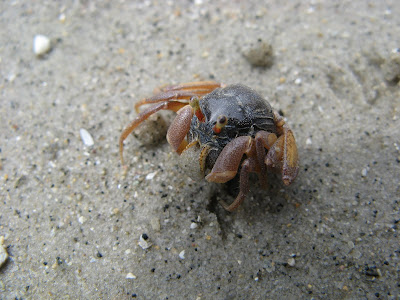
It was a pleasant surprised to see so many soldier crabs near to the jetty. Roy ( :P )said, there are 'tonnes' of soldier crabs at Cyrene Reef, Singapore. But Cyrene is patch reef and not as accessible. i have never seen the soldier crabs army before, so i think this is my birthday gift from the shore. :)

When the tide goes out, hoards of Soldier Crab emerge from their sandy burrows to ‘march’ across the sandy shore. Their ‘armies’ can range from a dozen individuals to hundreds, moving over the sand flats like an undulating carpet. (This is why they are called soldier crabs. They troop about in large numbers.)

Soldier Crabs are fascinating creatures to watch, as they swarm over the flats. Systematically, they pick up parcels of sand that are placed into their large and complex mouth-parts. The sand parcel is revolved around the mouth-parts where small pieces of organic matter are extracted and consumed, the sand-pellet is then dropped and the crab picks up another parcel of sand and the process is repeated. It is interesting to note that these crabs move forward on their stilt-like legs, not sideways like most crabs.

When disturbed, the crabs burrow sideways directly into the sand, a process that takes less than two seconds. Its bizarre to sit on a sand flat and watch a hundred crabs just disappear into the sand, then a couple of minutes later, they just pop up out of the sand and carry on feeding, a great anti-predator defence.

This is not a good picture...
Anyway, i think you can see a shrimp!
It hides under the rock and normally if you flip over a rock during low tide, you will see many life forms.
(Remember to flip back the rock gentlely after that.)
Shrimp are distinguished from the superficially similar prawns by the structure of the gills. There is, however, much confusion between the two, especially among non-specialists (like me :), and many shrimp are called "prawns" and many prawns are called "shrimp".
For most people, the difference between shrimp and prawns is based on size, with larger shrimp being called prawns.

A young Avicennia mangrove.
This fellow just simply grows too near to its mother tree and this could be a disadvantage to grow under the shade of the mother tree.
The pencil roots can be see clearly.
Since mangrove nud is poor in oxygen, the pencil roots help the tree to absob oxygen from the air.

i am not sure what kind of palm tree is this.
It grows by the coastal hill by the main road of jetty.

Unknown butterfly.
Take note with the shinning blue patch near to the edge of its wing.

An ant nest!

